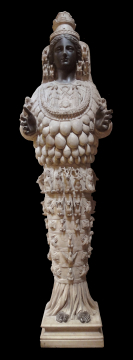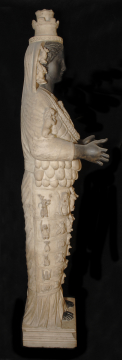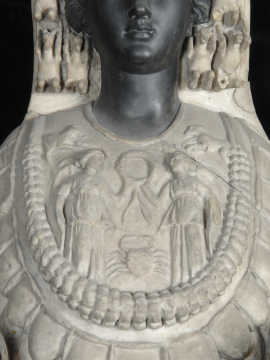Explore Collections


You are here:
CollectionsOnline
/
Restored torso of a statue of the Ephesian Artemis (or 'Ephesian Diana')
Browse
Restored torso of a statue of the Ephesian Artemis (or 'Ephesian Diana')
Pentelic marble, the hands and face restored in black marble
Height: 123cm
Height (torso, excluding restoration): 76cm
Height (torso, excluding restoration): 76cm
Museum number: M613
On display: Colonnade - central aisle
All spaces are in No. 13 Lincoln's Inn Fields unless identified as in No. 12, Soane's first house.
For tours https://www.soane.org/your-visit
Curatorial note
The head has a turreted crown and a nimbus on which appear protomai [the upper parts] of three griffins in a triangular arrangement either side of the head (all restored). Within the wreath of imortelles on the breastplate, a running bull (?: Thiersch calls it a stout, running boar) and a hare on the right (restored) above two standing Victoriae [Victory figures] (heads restored) holding a wreath between them with a crab below. On the arms, two lions sitting against the shoulders (only the feet, haunches, and ends of the tails of both are ancient). Below the stylised pendant necklace, composed of elongated double cones from which hang long 'acorn buds', all under the wreath, there are four rows of breasts, the ends of a number of which, especially near the front, are restored. Underneath the breasts, six rows of protomai separated by triple fillet moulding strips running around to each side. The single restored pieces are let into the torso separately, but the antique pieces were carved from the original block, a fact overlooked in previous descriptions. Since sections were cut out to let in the restorations, there were undoubtedly traces of the ancient protomai, as still remain in several cases, to guide the restorers in their work and produce results which, Thiersch noted, follow the established canon for Roman adaptations of the Artemis Ephesia.
The figures top to bottom, left to right - that is the protomai in the ependytes [outer garments] between the hoop-fillet borders, are as follows: (an asterisk after the piece indicates the whole or an identifying part is ancient)
1. Stag; winged female (*); three stags; winged female (*); stag.
2. Griffin, bee (*); three griffins; bee (*); griffin.
3. Ram, rosette (*); two oxen; rosette; ram.
4. Hare (?); bee (*); roe; bee; hare (?).
5. Eagle; rosette (*); eagle; rosette (*); griffin.
6. Rosette (*); bee; hare; bee; rosette.
The chiton (tunic) below the lowest zone, the feet, and plinth are, as indicated, all restorations.
(There were originally 3 fingers of black marble from the Ephesian Artemis separately housed in the Soane Museum which might belong to the restorations (*), Museum no. X208. Two fingers are today in the collection (Library Drawer 106E). George Bailey (AB Inventory of works of art 1837) notes that fingers were 'put on the statue 1841').
In the sketchbook in Siena (at one time incorrectly associated with Baldassare Peruzzi) which appears to contain the notes of a young Italian architect, who was studying the antique in Rome after the middle of the Sixteenth Century, there is drawn a 'Diana Efesia', near sketches of the Theatre of Ferentum (Hermann Egger, Jahrbuch der Kunsthistorischen Sammlungen des Allerhöchsten Kaiserhauses, XXIII (1902) p.41; Folio.51, etc.). This drawing shows the Soane statue with its correct feet, its original, simple headdress, its old kalathos base, and the zones running around the front as in its present condition. The head, neck, and hands were already lacking. Egger noticed that the Siena sketchbook-Soane statue was drawn by J.J. Boissard (in Rome 1555-1561) in his Topographia Urbis Romae (1597-1602), IV, p.118, both with at least the present restorations about the feet and many imaginary alterations in keeping with the seventeenth century antiquarian engraving. He gave as provenance for the statue 'in hortis Carpensibus'. Thiersch identified the Soane statue, therefore, as being the 'Dea della natura' drawn by Ulisse Aldrovandi (Delle statue Antiche che per tutta Roma 295) in 1550 in Cardinal Rodolfo Pio's celebrated garden antiquarium on the Quirinal. In this celebrated forerunner of the later Roman collections of antiquities, the Soane statue was seen cleverly placed above the Portal which led to a marvellous elm-lined court - the Cortile dell'Olmo, (Christian Hülsen, Römische Antikengärten des XVI Jahrhunderts, Heidelberg Akademie 4, 1917. p.55, no.2).
In spite of it's inclusion in Adolf Michaelis' description of the Soane collection (Michaelis p.474, no.3) of the Soane collection, the general academic inaccessibility of the Soane Artemis Ephesia prior to Thiersch's publication led to more harsh doubt than necessary about the seventeenth century engravings. From Boissard the 'restored' version of the Soane statue as interpreted in the late Sixteenth century appeared also in Vincenzo Cataris, Imagini delli Dei Antichi (Venice, 1647), p.298. H. Egger sensed that a real statue lay behind these fanciful adaptations, but Reinach in his Répertoire de la Statuaire (II, p.321, no.5) reproduced the figure as an imaginary statue. From Boissard also the statue became plate XCVI, no.1. in de Montfaucon's L'Antiquité expliquée (Paris, 1722, Vol.1, plate 95, p.159) beside which appears (no. 2) a representation drawn from Banduri's 'Bibliothetheca Nummaria' and even further removed from the antique. The walled crown of Boissard's engraving was given projecting towers, and the protomai on the trunk were creations connected with de Montfaucon's interpretation as the figure symbolic of the balancing natural forces of life. The fanciful derivation engraved by Montfaucon was republished by a Bonn doctor, Johann Christian Harless, (Die Verdienste du Frauen um Naturwissenschaft, Gesundheits und Heilkunde, Göttingen, 1830, pl.II) as 'Isis-Diana Bubastis'. The good doctor endeavoured to link the Ephesian Artemis with the Egyptian Isis, contending that the zones about the trunk were derived from mummy wrappings. He misunderstood the crab on the breastplate as a scarabeus.
There are several other Roman variations of the Artemis Ephesia which are fairly close to the Soane statue and which, like it, show arrangements of the ependytes in continuous zones or panels, perhaps under the influence of the slightly less widely copied Aphrodite of Aphrodisias cult statue type (see below, Soane no.378). A torso in the Museo Nazionale, Naples (Thiersch, pp.140-141, no.161, pl.LXXV, no.1) compares with the Soane torso in the division of the zones. The example from the collection of Dr. Robert Mond is also a Roman copy of this same general taste and arrangement of the costume-decorations, (Thiersch, no.9).
The statue in the collection of the Earl of Pembroke at Wilton, Wiltshire, (Thiersch, pp.54-55, no.38, pl.XXIV, no.1) which like the Soane statue has a long history in Renaissance and Baroque engraved collections of antiquities and which Thiersch temporarily confused with the Soane statue in this respect, is likewise a heavily restored torso of Roman variant origin. The number of the Ependytes zones is, however, reduced from six to four, and this enabled Thiersch to sort out the engravings which present fanciful variations of the Wilton House torso from those which are based on the Bessborough-Soane figure.
The fate of the statue between the time it was sketched in an unrestored and partially restored (?) state in Rome in the Sixteenth Century and its appearance in the collection of William Ponsonby, Second Earl of Bessborough (d.1793) is unrecorded. The Earl of Bessborough lived a great deal on the continent prior to 1739 and laid the foundation of his collection in Italy, where he may well have acquired the Ephesian Diana which Soane subsequently purchased at the sale of his collection. In the interval, probably before purchase by the Earl, the original headdress, etc., disappeared, and the well composed but of course iconographically inaccurate restorations which mark the statue in its present state were added.
The figures top to bottom, left to right - that is the protomai in the ependytes [outer garments] between the hoop-fillet borders, are as follows: (an asterisk after the piece indicates the whole or an identifying part is ancient)
1. Stag; winged female (*); three stags; winged female (*); stag.
2. Griffin, bee (*); three griffins; bee (*); griffin.
3. Ram, rosette (*); two oxen; rosette; ram.
4. Hare (?); bee (*); roe; bee; hare (?).
5. Eagle; rosette (*); eagle; rosette (*); griffin.
6. Rosette (*); bee; hare; bee; rosette.
The chiton (tunic) below the lowest zone, the feet, and plinth are, as indicated, all restorations.
(There were originally 3 fingers of black marble from the Ephesian Artemis separately housed in the Soane Museum which might belong to the restorations (*), Museum no. X208. Two fingers are today in the collection (Library Drawer 106E). George Bailey (AB Inventory of works of art 1837) notes that fingers were 'put on the statue 1841').
In the sketchbook in Siena (at one time incorrectly associated with Baldassare Peruzzi) which appears to contain the notes of a young Italian architect, who was studying the antique in Rome after the middle of the Sixteenth Century, there is drawn a 'Diana Efesia', near sketches of the Theatre of Ferentum (Hermann Egger, Jahrbuch der Kunsthistorischen Sammlungen des Allerhöchsten Kaiserhauses, XXIII (1902) p.41; Folio.51, etc.). This drawing shows the Soane statue with its correct feet, its original, simple headdress, its old kalathos base, and the zones running around the front as in its present condition. The head, neck, and hands were already lacking. Egger noticed that the Siena sketchbook-Soane statue was drawn by J.J. Boissard (in Rome 1555-1561) in his Topographia Urbis Romae (1597-1602), IV, p.118, both with at least the present restorations about the feet and many imaginary alterations in keeping with the seventeenth century antiquarian engraving. He gave as provenance for the statue 'in hortis Carpensibus'. Thiersch identified the Soane statue, therefore, as being the 'Dea della natura' drawn by Ulisse Aldrovandi (Delle statue Antiche che per tutta Roma 295) in 1550 in Cardinal Rodolfo Pio's celebrated garden antiquarium on the Quirinal. In this celebrated forerunner of the later Roman collections of antiquities, the Soane statue was seen cleverly placed above the Portal which led to a marvellous elm-lined court - the Cortile dell'Olmo, (Christian Hülsen, Römische Antikengärten des XVI Jahrhunderts, Heidelberg Akademie 4, 1917. p.55, no.2).
In spite of it's inclusion in Adolf Michaelis' description of the Soane collection (Michaelis p.474, no.3) of the Soane collection, the general academic inaccessibility of the Soane Artemis Ephesia prior to Thiersch's publication led to more harsh doubt than necessary about the seventeenth century engravings. From Boissard the 'restored' version of the Soane statue as interpreted in the late Sixteenth century appeared also in Vincenzo Cataris, Imagini delli Dei Antichi (Venice, 1647), p.298. H. Egger sensed that a real statue lay behind these fanciful adaptations, but Reinach in his Répertoire de la Statuaire (II, p.321, no.5) reproduced the figure as an imaginary statue. From Boissard also the statue became plate XCVI, no.1. in de Montfaucon's L'Antiquité expliquée (Paris, 1722, Vol.1, plate 95, p.159) beside which appears (no. 2) a representation drawn from Banduri's 'Bibliothetheca Nummaria' and even further removed from the antique. The walled crown of Boissard's engraving was given projecting towers, and the protomai on the trunk were creations connected with de Montfaucon's interpretation as the figure symbolic of the balancing natural forces of life. The fanciful derivation engraved by Montfaucon was republished by a Bonn doctor, Johann Christian Harless, (Die Verdienste du Frauen um Naturwissenschaft, Gesundheits und Heilkunde, Göttingen, 1830, pl.II) as 'Isis-Diana Bubastis'. The good doctor endeavoured to link the Ephesian Artemis with the Egyptian Isis, contending that the zones about the trunk were derived from mummy wrappings. He misunderstood the crab on the breastplate as a scarabeus.
There are several other Roman variations of the Artemis Ephesia which are fairly close to the Soane statue and which, like it, show arrangements of the ependytes in continuous zones or panels, perhaps under the influence of the slightly less widely copied Aphrodite of Aphrodisias cult statue type (see below, Soane no.378). A torso in the Museo Nazionale, Naples (Thiersch, pp.140-141, no.161, pl.LXXV, no.1) compares with the Soane torso in the division of the zones. The example from the collection of Dr. Robert Mond is also a Roman copy of this same general taste and arrangement of the costume-decorations, (Thiersch, no.9).
The statue in the collection of the Earl of Pembroke at Wilton, Wiltshire, (Thiersch, pp.54-55, no.38, pl.XXIV, no.1) which like the Soane statue has a long history in Renaissance and Baroque engraved collections of antiquities and which Thiersch temporarily confused with the Soane statue in this respect, is likewise a heavily restored torso of Roman variant origin. The number of the Ependytes zones is, however, reduced from six to four, and this enabled Thiersch to sort out the engravings which present fanciful variations of the Wilton House torso from those which are based on the Bessborough-Soane figure.
The fate of the statue between the time it was sketched in an unrestored and partially restored (?) state in Rome in the Sixteenth Century and its appearance in the collection of William Ponsonby, Second Earl of Bessborough (d.1793) is unrecorded. The Earl of Bessborough lived a great deal on the continent prior to 1739 and laid the foundation of his collection in Italy, where he may well have acquired the Ephesian Diana which Soane subsequently purchased at the sale of his collection. In the interval, probably before purchase by the Earl, the original headdress, etc., disappeared, and the well composed but of course iconographically inaccurate restorations which mark the statue in its present state were added.
Purchased by John Soane at Lord Bessborough's Sale, Roehampton, 7 April 1801, Lot 103, A CAPITAL and very CURIOUS statue of the DIANA of EPHESUS (the Dea Multimamma) the extremities of black marble see Montfaucon vol. 1, plate 95, p.158. Soane records his purchase in the margin of his copy of the Sale catalogue as costing 61 guineas (the separate receipt records £64.1s).
Literature
Description of Sir John Soane's Museum (guidebook), 1930, p.80.
Hermann Thiersch, Artemis Ephesia, Abhandlungen der Gesellschaft der Wissenschaften zu Göttingen, Berlin, 1935, vol. I, pp.5-11, pls. XIII, 2; LIII, 1; LIV, 1, 2, 3; also pp.54-55, pl.XXIV, 1 (Wilton House); pp.140-141, pl.LXXV, 1 (Museo Nazionale, Naples)
C. Seltman, 'The Wardrobe of Artemis' in Numismatic Chronicle, 1952, pp.40ff., pl.VI, 2.
Hermann Thiersch, Artemis Ephesia, Abhandlungen der Gesellschaft der Wissenschaften zu Göttingen, Berlin, 1935, vol. I, pp.5-11, pls. XIII, 2; LIII, 1; LIV, 1, 2, 3; also pp.54-55, pl.XXIV, 1 (Wilton House); pp.140-141, pl.LXXV, 1 (Museo Nazionale, Naples)
C. Seltman, 'The Wardrobe of Artemis' in Numismatic Chronicle, 1952, pp.40ff., pl.VI, 2.
Associated items
XF375, stand
Soane collections online is being continually updated. If you wish to find out more or if you have any further information about this object please contact us: worksofart@soane.org.uk















